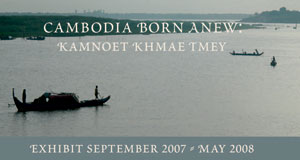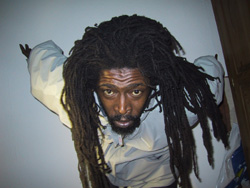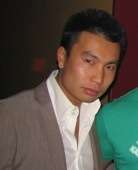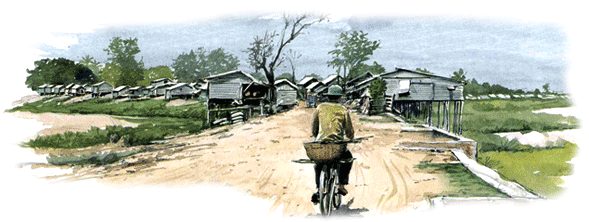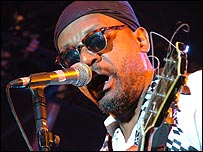So many tragic events befell the Cambodian people in the 70s and 80s and some of these are recalled by Justin Sok in the following article. He discusses the Preah Vihear tragedy where up to 45,000 Cambodian refugees were herded down the landmine-infested cliffs of Preah Vihear by the Thai army, in one of the most appalling acts of that era:
The Gate Keeper - by Justin C. SokI have read literature about the tragedy of Cambodian people. I hear horrible stories shared by Cambodian refugees on how they had survived and how they had managed to escape the “Killing Fields” from the tyrant Pol Pot-Ieng Sary clique (aka Khmer Rouge, Angkar Loeu’s regime). The Cambodian civilians, for generations, had been beset by civil wars and had endured unbearable suffering and extremely inhumane acts committed upon them by those so-called leaders, whose principal duty and responsibility were to “serve and protect” its own citizens and country. Those atrocities were far beyond the imagination of mankind.During the period of 3 and a half years under the Pol Pot-Ieng regime, an estimated of 1.7 million innocent Cambodian civilians were killed by systemic execution, disease, and mass starvation. Although the atrocities had happened over a quarter century ago, for the majority of Cambodian victims, it appears that their macabre life experiences and bitter memories, continues to have an enormous negative impact today on their daily lives. In spite of many obstacles and adjustment issues that they have to face everyday in their new environment, Cambodian survivors often participate in social gatherings, reminiscing with one another about their vivid memories and fateful past. Despite the horrific experiences they had survived, let us not forget the most heinous incident, which has recently recorded in our Cambodian literature, was the tragic incident that happened at the Preah Vihea mountain cliffs during the first six months of 1979.
In the early part of 1979, the Vietnamese invaded Cambodia. Within less than three weeks, the Vietnamese ousted the Pol Pot-Ieng Sary regime and installed its figurehead leader, Heng Samrin, to lead the People’s Republic of Kampuchea (now Cambodian People’s Party led by PM Hun Sen). The fighting between the Vietnamese and the Pol Pot-Ieng Sary troops continued in Northwest Cambodia. The relentless fighting created chaos and caused the first wave of hundreds of thousands of Cambodian refugees to flee to Cambodia-Thailand border.Desperately searching for freedom, Cambodian refugees trekked and trudged through wilderness, they had little food or water, walking days and nights, carefully navigated through a landscape teeming with landmines. In many incidents, they often encountered some small guerrilla factions, which were lying-in-wait for the right opportunity to rob, rape and torture, kill, and maim those refugees. The news about the influx of Cambodian refugees at the Cambodia-Thailand border had echoed into the international community. The officials from various humanitarian organizations including the United Nations High Commissioner for Refugees, United Nations Relief and Works Association, the International Committee of the Red Cross, diplomats, and journalists from the countries around the world reacted with great passion to help these Cambodian refugees. In January of 1979, Poul Hartling, former Danish prime minister, representative for the UNHCR had made a formal request to the Thai Prime Minister General Kriangsak Chamanand for the purpose of offering UNHCR help in dealing with the overflow of Cambodian refugees. The offer was not only “ignored” but the Royal Thai Government had attempted to keep not only journalists out but also all international aid officials from reaching to the Cambodian refugees. Leslie Goodyear, an Englishman, represented the Bangkok office of the High Commissioner brought the exigency attention to UNHCR headquarters in Geneva but was also “ignored.” The Royal Thai Government rejected, despite incessant requests made by journalists, international aid officials, and diplomats all offers of help, and pled not to repatriate those Cambodian refugees back to Cambodia. The only excuse the Royal Thai Government offered was the “Cambodian refugees threatened Thai national security and infringed Thai sovereignty.”
The Royal Thai Government was the “Gate Keeper,” which could render a judgment on the lives of the Cambodian refugees, sentencing them to either “heaven or hell.” The Royal Thai Government could choose to execute Cambodian refugees so easily, like turning an electrical switch, on and off, and no authority representing any country from around the world could stand in her way. For example, in mid April of 1979, the Thai military handed over approximately 50,000 Cambodian refugees to a group of about 8,000 Khmer Rouge soldiers. Since then, there was little information available on what really had happened to those Cambodian refugees. In May of 1979, approximately 826 Cambodian refugees had been taken in buses about 230 kilometers to another part of the border. Once they reached destination, they were ordered out of the buses and made to walk for two and a half hours “to a large mountain, which had a steep cliff on one side, 150-200 meters high. The whole group was pushed over the cliffs by Thai soldiers and killed.” Within the same month, another 250 Cambodian refugees more were pushed back to Cambodia, despite their pleas to stay and their fear of being killed by the Khmer Rouge. In mid May of 1979, officials from humanitarian organizations, international aid officials, and diplomats from international community put more pressure on the Royal Thai Government on the issue of “not to repatriate Cambodian refugees back to Cambodia.” This time the response from the Royal Thai Government was, “Thai authorities were not pushing people back but merely trying to ‘persuade’ them to return.” In addition, the Royal Thai Government had imposed conditions on the United Nations to provide her with “food and money for the refugees but Thai government would remain under control . . . . Thailand required was money not words . . . . Money in hand ..... food for the new arrivals should be bought in Thailand ..... it would be distributed by Thais ..... Thai did not want any foreign relief officials in the field . . . . Send the supplies to us . . . we will do it.”
Cambodian refugees vividly painted the dark image about their experiences when they were living in Thailand Refugee Concentration Camp in the early 1980’s. The camps were crowded, unsanitary, with a limited food supply, lack of health care facilities and medication, and a lengthy and uncertain wait for resettlement. They received, on a weekly basis, a small ration of food including rice, a small portion of chicken or pork, vegetables, and of course, the “century salty dried fish - Trey Plah Tu.” The water was transported in by truckloads. The water as supposedly portable water but was murky, muddy, and filthy with debris and duck or bird feathers. In addition, while awaiting for their resettlement, Cambodian refugees remained in the camps were vulnerable to robbery, rape, and extortion from inside and outside of the camps. During the day, the Thai soldiers harassed, beat, shot at, and sodomized and raped women, and at night, they had “intentionally” allowed the bandits and/or small group of guerrillas to come inside the camps to commit robbery, terrorize people, and rape women. From January through June of 1979, several international aid officials and foreign diplomats had made several attempted to negotiate with the Royal Thai Government on the issue of “not to repatriate the Cambodian refugees back to Cambodia.” The negotiations, however, were fruitless. And so the tragedy of Cambodian refugees continued.
In June of 1979, the authorities ordered most foreigners out of the refugee camps and nearby towns. Several hundreds of thousands of Cambodian refugees were herded from different temporary campsites all over eastern Thailand. They were prodded and beaten by Thai soldiers before they climbed fearfully into buses. The Thai soldiers told the refugees they were being moved to another, a better camp to await resettlement. Hundreds of buses took those Cambodian refugees on a long journey toward a mountainous region of the northeastern border near the temple of Preah Vihear. They arrived at the destination after dark and with several hundred Thai soldiers were waiting for them there. The Cambodian refugees were then ordered to get off the buses and walk down the steep cliffs back into Cambodia. People meticulously and cautiously tried to walk down the steep cliffs by holding on to sticks and tree branches to steady themselves, or sliding down through vines. A small group of refugees attempted to climb back on toward the Thai soldiers, carrying with them a white flag, but the Thai soldiers opened fired and killed them all. When they reached valley floor, there were hundreds of thousands of landmines planted by the Pol Pot-Ieng Sary regime and the Thais there. Making their way through an austere landscape toward a certain death, the people were crawling or in a sitting position, scooted over inch-by-inch, at a snail’s pace, trying to avoid the mines. Recently, I had an opportunity to do an informal interview with Cambodian survivors about the tragic incident that happened at Preah Vihea. One Cambodian survivor attested, “It took me a whole day to scoot over, inches at a time, approximately 5 meters. Like popcorns popping in the hot pan, people stepped on landmines and were blown up into pieces. The jungle was littered with corpses and debris of human body parts and pieces were ubiquitous: hanging from the tree branches or lying motionless on the ground. Children were crying and people were dying of thirst and hunger. I will never ever forget that as long as I live!”There was not any information available on how many days the Royal Thai Government carried on this operation. However, according to William Shawcross, there were between 43,000 to 45,000 Cambodian refugees who were pushed down the cliffs at Preah Vihear.
It was indeed a tragedy caused by the “ignorant.” This political matter, which could be diplomatically resolved to save the lives of those hundreds of thousands of innocent Cambodian refugees, if the Royal Thai Government was to give some leeway on the grounds of humanitarian principles and acquiesced to the requests made by the international aid officials and foreign diplomats. Several times, the Royal Thai Government had turned down these requests and chose to “collaborate” and served as an “accomplice” to the Khmer Rouge regime, instead. My legal objective opinion on this historical atrocity is that, the Royal Thai Government had allegedly committed the following: (1) denied the Cambodian refugees the “basic rights of humanity”, (2) consistent patterns of gross violations human rights, and (3) committed mass murder. The Royal Thai Government, as a matter of law, is as guilty as the leaders of the Khmer Rouge regime of this atrocity. To the United Nations and the world legal community, what are the remedies and legal grounds, if any, which could hold the Royal Thai Government responsible for her grossly inhumane acts committed on those unfortunate Cambodian refugees?
Link: Read more about the border camps on the Thai-Cambodian border
here. In addition, I'm still reading a book called
Climbing Back Up by Kim Chou Oeng, which contains his personal experiences during the Khmer Rouge years as well as a shocking description of that decision by the Thai authorities in 1979, to forcibly repatriate around 45,000 Cambodians refugees.
* * * * *
Breaking News...Police detained the top surviving leader of the Khmer Rouge,
Nuon Chea, this morning over his role in the notorious former Cambodian regime that caused the deaths of 1.7 million people in the late 1970s. He was taken by police escort from his home in Pailin in northwestern Cambodia near the Thai border, police and witnesses said, and was to be be flown by helicopter to the capital Phnom Penh. Nuon Chea helped the group's infamous leader Pol Pot seize control of Cambodia's communist movement in the 1950s and '60s and then became the movement's chief political ideologue during its murderous rule in the 1970s. Prosecutors for the UN-backed genocide tribunal investigating crimes by the Khmer Rouge have not publicly named Nuon Chea as a suspect. But he is believed to be one of five senior Khmer Rouge figures they have recommended for trial before the panel. Already in detention is Comrade Duch, chief of the notorious Tuol Sleng Prison.
Link: For background info, you can read two reports on Nuon Chea on the
PBS website and at the
Cambodia Daily.
